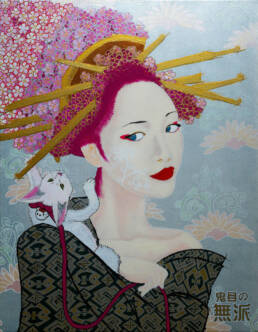(I Think Her Name’s)
Debra
I have a few canvases that I have no plans for, just laying around waiting to be picked up and used, ideal for trying out some new ideas. Lately I have been thinking about portrait in painting, one thing that I am not particularly fond of. Last time I did a classical portrait was in 2000, I think, I was in my third year of the Academy of Fine Arts, and I was sick of it. To my understanding a portrait as a visual and a factual 3D representation of someone’s face on canvas has belonged to the past since the beginning of Modern art, and as such could only belong to photography, as all realism does. Whenever someone asks me for “real” portrait I recommend them to pay a visit to my friends at VTF (photo) Studio. I think I got inspired by my friend´s work, Nana Monda, to start thinking about portraits in combination with flat background. Nana is a master of bijin-ga. She does this wonderful long neck beautiful woman bust portraits, in combination with flower designs that have tradition in ukiyo-e. So I picked up a print Motozue of the Daimonjiya, from the series Contest of Beauties of the Pleasure Quarters (Kakuchû bijin kurabe) by Chokosai Eisho, one of my favorite ukiyo-e masters, to reproduce as painting for my 100 Views of Ukiyo-e: Volume II (2019- ) series of paintings, but in the sketching process I decided to keep some parts of composition, and I built something new out of it. I wanted to have realistic face with “coming out of sakura” hair. I used two random photos of woman face from the Internet and blended it with existing composition. So, it is not Motozue of the Daimonjiya, but also it is not someone specific.
Now, one of my favorite Beck (Hansen) songs is Debra, a funk/soul song that, what I thought at the time, was about a guy hitting on girl so he could meet (hook up with) her sister Debra. Through the whole song we hear about Jenny, and nothing of Debra, there is a good chance that it is not even her name. So I wanted to give face to this mystical Debra. This led me to do some digging about the song and all I could find is that Beck wrote it as a joke on R&B songs, trying to emphasize how those songs could be at same time emotional, sexist and rude. So it is about a guy who is hitting on a girl to have a ménage à trois with her and her sister…
(I think her name is) Debra.
Floral background is very common in ukiyo-e and from there Europe took patterns for wallpapers and distributed them worldwide. I did hand drawn/painted rose floral to achieve diversity through variations, same and yet not the same. Variations and diversity lead to life, mistakes are evolution. My friends thought that I went nuts and that I have started designing wallpaper patterns, in most masochistic way by not actually creating or using pattern. Truth is, I went nuts because I didn´t use pattern, and it took me forever just to finish background. But as they say, you cannot make an omelet without having a few breakdowns. When I started painting Debra I experienced such a joy that I would catch myself busting a move to Tricky Kid song by Tricky or the entire album the Body Gave You Everything by Magnus while painting. I needed to make breaks, wash dishes, make espresso and have it while trying to mindlessly stare into Baščarija to bring myself down, so I could continue painting again and stay on track. I would get this mad look in my eyes that only my close friends know when my frontal cortex is in Interzone. To keep memory of this I embedded this state into the signature and I also paid homage to one of my favorite anime.
Technique: acrylic on canvas
Size: 90 x 70 cm
Year: April 2020
Availability: In Private Collection
Bijin-ga (Paintings of the Beautiful Person)
When you have a friend like Nana Monda, it is hard not to enjoy bijin-ga. Her paintings have been constantly influencing my work. For me she is a truly living master of bijin-ga. Next in line is my friend Nataša Konjević, whose fantastic mixture of magic and portraits never fail to amaze me.
Bijin-ga is commonly translated as Portraits of beautiful women but it should be translated as Portraits of beautiful person, an individual, something that reflects inner beauty, gender is not specified at all. This leaves opening to gender fluidity in my future paintings from this series.
In my bijin-ga I will try to grasp iki – いき feeling, a beautiful sensual situation or a personal charm, where a viewer is a discreet witness to this moment.





